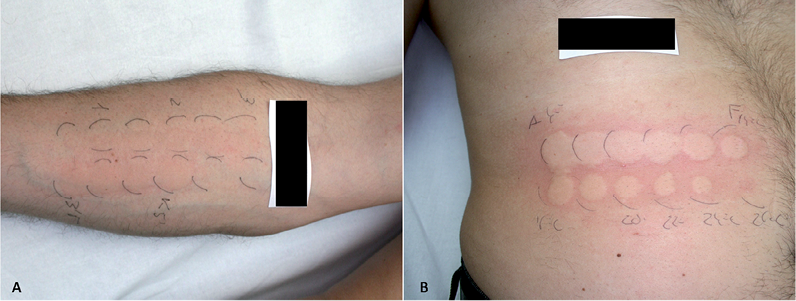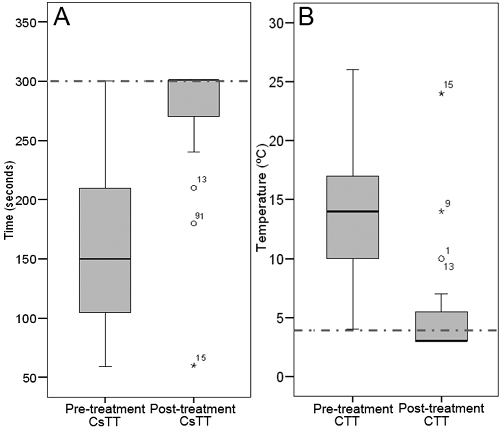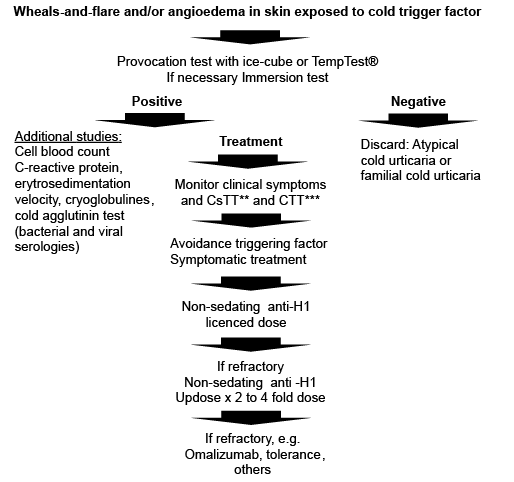M. Estela Martinez-Escala, Laia Curto-Barredo, Lluïsa Carnero, Ramon M. Pujol and Ana M. Gimenez-Arnau
Department of Dermatology, Hospital del Mar, Barcelona, Spain
Cold contact urticaria is the second most common subtype of physical urticaria. Cold stimulation standardized tests are mandatory to confirm the diagnosis. The aim of this study is to define the utility of determining thresholds (critical time and temperature) in assessment of the clinical course of typical acquired cold contact urticaria. Nineteen adult patients (10 women and 9 men; mean age 45 years) were included in the study and the diagnosis was confirmed with the ice-cube test and TempTest® 3.0. Patients were treated continuously for one year with 20 mg/day rupatadine (anti-H1). Thresholds measurements were made before and after treatment. Improvements in temperature and critical time thresholds were found in the study sample, demonstrating the efficacy of continuous treatment with rupatadine. In most cases association with a clinical improvement was found. We propose an algorithm for the management of acquired cold contact urticaria based on these results. Key words: cold urticaria; rupatadine; urticaria.
Accepted Jun 30, 2014; Epub ahead of print Jun 30, 2014
Acta Derm Venereol 2014; XX: XX–XX.
Ana M. Giménez-Arnau, Department of Dermatology, Hospital del Mar, Passeig Marítim 25–29, ES-08003 Barcelona, Spain. E-mail: 22505aga@comb.cat
Acquired cold urticaria (ACU) is a physical urticaria characterized by wheals and/or angioedema developing in response to exposure to cold air, liquids or solids (1). It is the fourth most common type of urticaria after chronic spontaneous, dermographic and cholinergic urticaria (2), and women are affected twice as often as men (3, 4). Symptoms are usually limited to cold-exposed skin areas, but extensive cold contact may result in generalized symptoms, such as headache, dyspnoea, hypotension and loss of consciousness (5, 6). Hives are caused by histamine (7–10) and other mediators, such as platelet-activating factor (PAF) and cytokines released from activated mast-cells, after exposure to cold triggering factors (1, 2, 11–16). To confirm the diagnosis cold stimulation standardized tests are mandatory.
Diagnosis is made via provocation testing. Ice-cube or cold pack provocation tests are the traditional standardized methods, although when such tests are negative in cases of clinically high suspicion, the cautious submersion of one hand in cold water may be indicated. In addition, an objective method has been devised using a Peltier element-based provocation device, the TempTest® (2, 17, 18), to establish the highest temperature and/or shortest stimulation time that will induce a wheal-and-flare reaction. Simultaneous application of 12 different temperatures, from 4.0°C to 42.0°C, allows rapid, reproducible, standardized evaluation of the critical temperature threshold (CTT). With the cold stimulation time threshold (CsTT) we could also evaluate the wheal induced by 4.0°C stimulation at different exposure times. Therefore, in addition to the diagnosis of ACU, assessment of CsTT and CTT is recommended to define the severity of the condition (16, 17, 19).
The management of patients with ACU is based on avoiding triggering factors, combined with treating symptoms with non-sedating anti-H1. Some second- and third-generation anti-H1 drugs (cetirizine, desloratadine, ebastine, bilastine, mizolastine, cinnarizine and rupatadine) have been specifically tested in ACU, and have shown an immediate efficacy in such patients (18, 20–30); for a review, see Buss & Sticherling (31) and Weinstein et al. (32).
Clinical assessment of the therapeutic response in terms of signs and symptoms of ACU was originally carried out with the Acquired Cold Urticaria Severity Index (ACUSI) (18), but traditional methods, such as subjective surveys answered by patients, have also been used (33). Generic instruments evaluating health-related quality of life (HRQoL) are increasingly used to evaluate disease treatment, but they do not cover all possible aspects of urticaria diseases and are not specifically standardized for global comprehensive assessment of ACU (13). Furthermore, none of these non-standardized and subjective methods of assessing clinical response to treatment appear to be reproducible. Siebenhaar et al. (17) describe the objective measurement of disease activity and the response to therapeutic interventions using electronic TempTest® equipment (34). This reliable method enables the precise and accurate control of treatment effects on the basis of monitoring threshold temperatures.
The primary objective of the current study is to describe the advantage of determining the stimulation time and temperature thresholds in the assessment of the clinical course of typical ACU, as measured with the TempTest® 3.0. A secondary objective is to evaluate the long-term efficacy of continuous treatment of patients with ACU with the non-sedative anti-H1 rupatadine (20 mg/day) in an open trial. This dosage has previously been found to be immediately effective in controlling the symptoms of ACU (28); for a review see Nettis et al. (35). A pilot study in 3 non-atopic patients with idiopathic and refractory ACU found this dosage to be effective after 2 weeks for treatment of pruritus in ACU (27). Based on the results of the current study a new algorithm for the management and treatment of ACU is proposed.
MATERIALS AND METHODS
Patients
Nineteen consecutive outpatients attending the Hospital del Mar (Barcelona) with a confirmed clinical history of ACU were recruited from 2009 to 2010 in a prospective observational scenario.
Exclusion criteria were: age under 18 years; treatment with antihistamines, systemic steroids or other systemic immunosuppressant therapies in the 4 weeks prior to the study; pregnancy or trying to conceive. The nature of primary ACU was confirmed after exclusion of concomitant conditions known to be associated with cold urticaria, e.g. cryoglobulinaemia or cryopyrin-associated periodic syndromes (CAPS).
After a blanching period of 15 days, the clinical ACU diagnosis was confirmed both by standardized ice-cube provocation testing and with the Peltier effect-based electronic device TempTest® 3.0 (Emo Systems, GmbH, Berlin, Germany). The ice-cube test was carried out on the volar aspect of the patient’s forearm using a standardized protocol (1, 16). A melting ice-cube in a plastic bag was held in contact with the skin and removed after 5 min. Ten min after removal the ice-cube wheal response was assessed.
The study was performed according to usual clinical practice. Signed informed consent was obtained in all cases, including informed consent for medical images.
Interventions: treatment and threshold assessments
Rupatadine, 20 mg/day, was prescribed for continuous treatment for one year (27, 28) (Fig. S11). Patients underwent threshold assessment (CsTT and CTT) by TempTest® 3.0 at enrolment and at the end of the study period, always after a blanching period of 15 days of antihistamine treatment.
The CsTT was defined as the shortest time to develop a wheal through cold provocation, and the CTT was defined as the highest temperature at which a wheal was induced. CsTT was assessed on the volar aspect of the patient’s forearm, exposing the skin to 4°C for periods of time from 60 s to 5 min, at 30 s intervals (Fig. 1A). CTT was assessed on the patient’s abdomen, exposing the skin at 2°C intervals from 4°C to 26°C for 5 min (Fig. 1B). Fifteen minutes later, the resulting wheals were assessed. The upper arm and, especially, the abdomen are the body areas recommended for use in the provocation test due to their particular sensitivity.
Thus, in total, 2 CsTT measures and 2 CTT measures were made during the study. A paired t-test was used to compare pre- and post-measures. Increased time to the wheal development and reduction in temperature (in °C) pre-treatment vs. post-treatment were also calculated.

Fig. 1. Cold provocation testing with TempTest® 3.0. (EMO Systems GmbH, Berlin, Germany). A positive cold provocation test at baseline assessment. (A) Positive test reaction after critical stimulation time threshold (CsTT) tested on the volar aspect of the patient’s forearm. CsTT in the test reaction site < 60 s. (B) Positive test reaction after critical temperature threshold (CTT) tested in the patient’s abdomen. CTT in the test reaction site was 24°C.
Patients were asked in the clinical setting (using unstructured methods) about their daily routines and clinical symptoms. Information about disease activity was collected in 3 main categories: (i) presence of wheals induced by cold exposure to liquids, solids and air during daily activities; (ii) presence of wheals only in risky situations, such as immersion in liquids; and (iii) no symptoms.
Follow-ups were performed every 3 months for the duration of the study. Patients who were asymptomatic with negative CTT and CsTT thresholds stopped anti-H1 treatment, and underwent follow-up at 6, 12 and 18 months. This global therapeutic approach is in agreement with previous studies in which ACU was treated with non-sedative anti-H1 (27, 28).
RESULTS
Demographic characteristics
Ten women and 9 men (all Caucasian) were included in the study. Their mean ± SD age was 45 ± 9.3 years; range 28–62 years). Mean ± SD cold urticaria duration at baseline was 5 ± 5.2 years; range 1–22 years). Any loss of follow-up during the one year of treatment was registered.
Urticaria stimulation thresholds: efficacy measurements
The CsTT mean ± SD at baseline was 2 min and 35 s ± 1 min and 9 s; range 1–5 min) at 4°C and it was significantly increased to 4 min and 28 s ± 1 min and 6 s; range 1–5 min) after one year. Therefore, a one-year period of treatment with rupatadine, 20 mg/day, was associated with significant increase in CsTT, with a mean of 39.8% (t = 7.77, p < 0.0005) (Fig. 2A and Fig. S2A1). Similarly, the CTT mean ± SD at baseline was 13.7 ± 6.0°C; range 26°C–4°C), and it improved significantly after treatment to 5.7 ± 5.5°C; range 24–3°C) (t = 6.60, p < 0.0005), indicating a mean temperature reduction of approximately 60% (Fig. 2B and Fig. S2B1). After one year of continuous treatment with non-sedative anti-H1 all patients showed a reduction in CTT (Table SI1 summarizes the results for individual patients).

Fig. 2. (A) Critical stimulation time threshold (CsTT) and (B) critical temperature threshold (CTT) measurements pre- and post-treatment with rupatadine 20 mg/day. Box-plots and outliers are shown. An improvement after one year of treatment with rupatadine was observed in patients with acquired cold urticaria (ACU). Pre- and post-differences were significant at p < 0.0005.
From a longitudinal pre–post viewpoint, and regarding clinical symptoms, 13 patients were free of symptoms both during their daily activities (with no symptoms when exposed to cold liquids, solids or air) and during risky activities (e.g. immersion in cold water), showing a long-term complete response with undetectable thresholds at the end of the study. Two out of 6 patients showed ≥ 50% reduction in CTT associated with longer CsTT compared with baseline measures and, clinically, the symptoms appeared only in risky situations. The remaining 4 patients remained clinically symptomatic during their daily activities, with an improvement of ≤ 30% in CTT and slightly longer CsTT. In total, 31.6% of the sample at one year still showed active symptoms and were suitable to undergo treatment, by increasing the anti-H1 dose or using immunomodulation.
During the 6-month follow-up after stopping treatment, those patients who showed a complete response remained asymptomatic. Only one patient had a relapse, developing cold-induced wheals one year after stopping treatment.
No side-effects were detected in any of the patients in the study sample during the one-year treatment with rupatadine.
An algorithm for the management and treatment of patients with ACU is shown in Fig. 3.
Fig. 3. Proposed algorithm for the management and treatment of acquired cold urticaria (ACU). The algorithm involves monitoring the Acquired Cold Urticaria Severity Index (ACUSI), the critical stimulation time threshold (CsTT) and the critical temperature threshold (CTT) as the first step in the treatment of the disease. In refractory patients, updosing anti-H1 4 times is proposed as a first step, and considering alternative treatments (i.e. immunomodulatory agents) as a second step.

DISCUSSION
To our knowledge this is the first study to demonstrate that monitoring patients with ACU in normal clinical practice using the Peltier-effect electronic device TempTest® is useful in assessing the clinical course of ACU and the patients’ response to treatment. This methodology has not been used previously for testing thresholds as efficacy measurements of long-term and continuous, daily treatment with a non-sedative anti-H1.
The management of ACU is based on avoiding triggering factors, such as cold liquids, air or solids, and controlling symptoms with non-sedating anti-H1 (2, 13, 16, 31, 33). Until now, there has been no formal recommendation about whether anti-H1 treatment should be given continuously or on-demand. In addition, there are no previous studies on when and how to stop the treatment, or whether the available treatments interfere with the disease prognosis. The temperature and/or time thresholds were studied by performing the provocation test with the TempTest®, enabling us objectively to monitor the disease severity and activity. In addition, this can help patients better to recognize and control cold exposure in their daily lives.
Based on the results of the current study we suggest that continuous treatment with anti-H1 has a better outcome than on-demand treatment.
By taking as our main end-point the evaluation of the CsTT and CTT by TempTest® after one year of rupatadine treatment (20 mg/day), we demonstrated an improvement in both efficacy measures. Two previous studies have shown a decrease in the CTT after a therapeutic intervention in ACU (19, 34). Mlynek et al. (19) showed a correlation between decrease in CTT and clinical improvement of the disease. In that study, the clinicians assessed CTT in patients affected by ACU using the cold-stimulation test (TempTest®) at baseline and 6–18 months after a therapeutic intervention (different interventions were applied: cold desensitization, non-sedating anti-H1 and potentially curative medications, as antibiotics). A higher CTT was detected in clinically severe cases and an inverse correlation was demonstrated between changes in CTT and disease activity. A study by Magerl et al. (34) did not correlate CTT data with clinical severity, but demonstrated a greater improvement in CTT with increasing doses of desloratadine up to 20 mg, compared with constant doses (5 mg) over a 6-week period. Our earlier placebo-controlled study of 1-week treatment with rupatadine at the same dose (20 mg/day) demonstrated a significant improvement in both CsTT and CTT efficacy measurements by means of the TempTest® 3.0 (28).
The results of the current study are similar to those of the previous studies, but with the inclusion of a specific continuous 1-year treatment. To our knowledge there have been no studies with such long homogeneous interventions where the efficacy was objectively measured. Other studies of a specific intervention, usually with non-sedating anti-H1 (24, 31, 32), have been no longer than 6 weeks. In addition, these studies assessed the efficacy of non-sedating anti-H1 to inhibit wheal formation after exposure to trigger factors.
With regards to our second objective, an increase in CsTT and a reduction in CTT were observed in our group; therefore long-term treatment with rupatadine, 20 mg/day, was highly effective in our sample, as measured using an accurate standardized device, the TempTest®. A complete response was obtained in 13 out of 19 patients. These results demonstrate the immediate and long-term efficacy of this treatment for ACU. Of the patients screened to be treated during this observational study only 2 did not agree to continuous treatment (not included in the analysis) and they followed an “on-demand” rupatadine treatment. In the 2 patients who neither improved clinically nor showed improvements in their thresholds, higher doses of non-sedating anti-H1 or, even better, of immunomodulatory agents, were required (36). Finally, of the patients included in the analysis, 6 months after the end of the one-year treatment only one patient had a relapse of the cold-induced wheals.
As for chronic spontaneous urticaria, an algorithm is needed, setting out the best way to treat and follow these patients clinically. There is no consensus on how to treat cold contact urticaria. The published studies use differing doses of non-sedating anti-H1, therapeutic plans and follow-up assessments (18, 20, 26, 29). Moreover, there have been no studies comparing the efficacy and side-effects of on-demand vs. continuous treatment, and this research is needed in order to determine the best regimen for these patients. As there is wide variation in the management and treatment of ACU, a specific protocol is needed for standardized management of ACU. The preliminary algorithm presented here emphasizes: (i) monitoring of clinical symptoms, CTT and CsTT; (ii) updosing anti-H1 4 times in non-responding patients; and (iii) considering alternative treatments (i.e. immunomodulatory agents) in refractory cases.
Study limitations
The current study has some limitations; for example, small cohort size and lack of a control (placebo) group with randomized interventions. Based on the promising results of this first open pilot study, further double-blinded randomized studies are required to determine the long-term benefits of the minimum effective anti-H1 dose used continuously to treat ACU. Future studies with large samples are required; however, the existing limitation of sample size in our study is partially compensated for by the use of a standardized accurate technique for monitoring treatment efficacy.
Conclusion
This preliminary study, evaluating the continuous treatment of ACU with rupatadine, 20 mg/day, for a period of one year, demonstrated good outcomes. Improvements in CTT and CsTT were detected in patients enrolled with this therapeutic intervention. In addition, an association between clinical improvement (and even complete remission) and a reduction in CTT was found. An algorithm for the management and treatment of patients with ACU is proposed, emphasizing the interest in monitoring efficacy measures using TempTest® in the management of the disease.
ACKNOWLEDGEMENTS
The authors would like to thank Mónica Giménez for her assistance in drafting the manuscript.
The authors declare no conflicts of interest.

1http://www.medicaljournals.se/acta/content/?doi=10.2340/00015555-1918
REFERENCES
